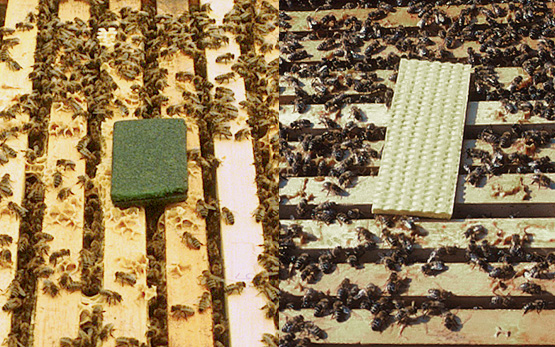Kast C., Kilchenmann V., Charrière J.-D.
Long-term monitoring of lipophilic acaricide residues in commercial Swiss beeswax.
Pest Management Science, online, (25 April), 2021, 1-8.
Roncoroni F., Kilchenmann V., Bieri K., Ritter R., Kast C.
Pollensammelverhalten von Bienenvölkern am gleichen Standort.
Schweizerische Bienen-Zeitung, 02, 2021, 16-19.
weitere Sprachen: französisch
Roncoroni F., Lucchetti M., Kilchenmann V., Kast C.
Honigbienen schützen durch Futtersaftproduktion ihre Larven vor Giftstoffen im Pollen.
Schweizerische Bienen-Zeitung, 07, 2020, 12-16.
weitere Sprachen: französisch | italienisch
Grossar D., Kilchenmann V., Forsgren E., Charrière J.-D., Gauthier L., Chapuisat M., Dietemann V.
Putative determinants of virulence in Melissococcus plutonius, the bacterial agent causing European foulbrood in honey bees.
Virulence, 11, (1), 2020, 554-567.
Droz B., Kilchenmann V., Kast C.
Coumaphos im Wachs: ein Risiko für die Bienengesundheit.
Schweizerische Bienen-Zeitung, 2, 2020, 13-15.
weitere Sprachen: französisch | italienisch
Roncoroni F., Kast C., Kilchenmann V.
Wichtige Pollen-und Nektarquellen für die Honigbienen in der Schweiz.
Hrsg. Agroscope, Zentrum für Bienenforschung, Bern. 30. März, 2020, 45 S.
weitere Sprachen: französisch | italienisch
Roncoroni F., Kilchenmann V., Bieri K., Kast C.
Welche Pollenarten sammeln unsere Bienen in Basel?
Schweizerische Bienen-Zeitung, 1, 2020, 15-17.
weitere Sprachen: französisch | italienisch
Roncoroni F., Kilchenmann V., Bieri K., Conedera M., Kast C.
Welche Pollenarten sammeln unsere Bienen im Tessin?
Schweizerische Bienen-Zeitung, 12, 2019, 16-19.
weitere Sprachen: französisch | italienisch
Kast C., Kilchenmann V., Droz B.
Distribution of coumaphos in beeswax after treatment of honeybee colonies with CheckMite® against the parasitical mite Varroa destructor.
Apidologie, online, (november), 2019.
Kast C., Kilchenmann V., Reinhard H., Bieri K., Zoller O.
Pyrrolizidine alkaloids: the botanical origin of pollen collected during the flowering period of Echium vulgare and the stability of pyrrolizidine alkaloids in bee bread.
Molecules, 24, (12), 2019, 1-14.
Lucchetti M., Kilchenmann V., Glauser G., Praz C., Kast C.
Nursing protects honeybee larvae from secondary metabolites of pollen.
Proceedings of the Royal Society B: Biological Sciences, 285, (1875), 2018, 1-8.
Gehring E., Kast C., Kilchenmann V., Bieri K., Gehrig R., Pezzatti G.B., Conedera M.
Impact of the Asian Chestnut Gall Wasp, Dryocosmus kuriphilus (Hymenoptera, Cynipidae), on the chestnut component of honey in the Southern Swiss Alps.
Journal of Economic Entomology, 111, (1), 2018, 43-52.
Kast C., Kilchenmann V., Reinhard H., Droz B., Lucchetti M., Dübecke A., Beckh G., Zoller O.
Chemical fingerprinting identifies Echium vulgare, Eupatorium cannabinum and Senecio spp. as plant species mainly responsible for pyrrolizidine alkaloids in bee-collected pollen.
Food Additives & Contaminants. Part A, 35, (2), 2018, 316-327.
Kast C., Kilchenmann V., Roetschi A.
Was bedeuten Backhefen im Honig?
Schweizerische Bienen-Zeitung, 03, 2017, 16-17.
weitere Sprachen: französisch
Lucchetti M. A., Glauser G., Kilchenmann V., Dübecke A., Beckh G., Praz C., Kast C.
Pyrrolizidine alkaloids from Echium vulgare in honey originate primarily from floral nectar.
Journal of Agricultural and Food Chemistry, 64, (25), 2016, 5267-5273.
Kast C., Dübecke A., Kilchenmann V., Bieri K., Böhlen M., Zoller O., Beckh G., Lüllmann C.
Analysis of Swiss honeys for pyrrolizidine alkaloids.
Journal of Apicultural Research, 53, (1), 2014, 75-83.
Kast C., Dübecke A., Kilchenmann V., Bieri K., Beckh G., Lüllmann C.
Pyrrolizidine Alkaloids in Honey from Switzerland.
In: Frühjahrstagung 2013. 19. März, Hrsg. Schweizerische Vereinigung für Tierproduktion, Posieux. 2013, 18-18.
Bösch, M., Kast C., Kilchenmann V.
4. Olma Honig-Prämierung: Einladung zur Teilnahme für Siegelimker.
Schweizerische Bienen-Zeitung, (6), 2010, 42-43.
Aupinel, P., Fortini, D., Michaud, B., Medrzycki, P., Padovani, E., Przygoda, D., Maus, C., Charrière J.D., Kilchenmann V., Riessberger-Galle, U., Vollmann, J., Jeker, L., Janke, M., Odoux, J.-F., Tasei, J.-N.
Honey bee brood ring-test: method for testing pesticide toxicity on honeybee brood in laboratory conditions.
Julius-Kühn-Archiv, 423, 2009, 96-102.
Bogdanov, S., Bieri, K., Kilchenmann, V., Gallmann, P.
Schweizer Sortenhonige (Neuauflage 2008).
ALP forum, 23 d, 2008, 1-56.
weitere Sprachen: französisch | italienisch






